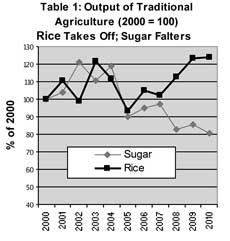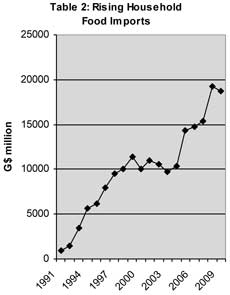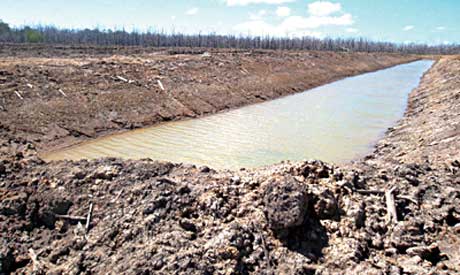Guyana Focus
commitment by govt
not matched with strategic planning

(Final of 2 parts)
The dramatic decline in non-traditional agricultural output over the past ten years is indicative of the fact that government efforts to stimulate the sector have failed. This is not necessarily due to a lack of perceived effort on the part of the government but more so due to poor strategic planning and implementation.
To make matters worse, the government has periodically given the false impression that the non-traditional agricultural sector has been performing well in recent years – apparently fuelled by occasional spurts in production which use a low


base for comparison. For instance, in 2010 cassava production was 22.7% of what it was in 2000. But if production were to quadruple in 2011, it would still be below 2000 output (See Part 1, Table 1). However, a typical government announcement would read: "Cassava production increases by 400% in 2011." Such statistics are fallacious – though true for the current period - are misleading to the average person in terms of long-term growth in production.
Yet government's expectations for non-traditional agriculture have been high, so much so that it recently made a pronouncement that it aims to be the region's main food supplier. In reality, the country is no further ahead than it was when it first laid claim to its potential as "the food bowl of the Caribbean" more than a half a century ago.
There is no doubt that it makes sense to emphasize non-traditional agriculture. From a strategic standpoint, increased output enhances food security, an issue which came to the forefront a couple of years ago in the wake of high food prices. As well, the potential for exports is high, which has been a key government objective in its quest to develop the sector.
However, broad-based success in non-traditional agriculture has been evasive – for the current as well as past governments. Its' development hinges on the extent of government commitment and the existence of a comprehensive plan to guide the sector's growth. Government commitment – at least verbally and financially apparently does exist – but planning is ad hoc. A comprehensive strategic plan that guides the development of the sector is unavailable.
Past experience shows that there has been weak integration of implementation efforts, resulting in sporadic ventures that have engendered limited success. In fact, over time there have been more failures than successes in a broad spectrum of non-traditional sub sectors.
Although Guyana has the physical resources to ensure success in non-traditional agriculture, it would not be prudent to ignore the reasons for failure. Output has been affected by the vagaries of weather, diseases and floods, which have led to production shortfalls and substantial losses by farmers who have become increasingly disenchanted.
Ironically, the traditional rice sector which is highly vulnerable to poor weather conditions has significantly outperformed all other food crops over the past ten years – a fact that that casts some doubt over poor weather as being a major contributor to declining output in the non-traditional agriculture sector. Chart 1 compares the performance of the rice sector with the government-controlled sugar sector. Rice production has been greater than the benchmark year 2000 in eight of the ten years between 2001 and 2010, while sugar production, which has declined steadily over the past five years has outperformed the benchmark year in only four of the past ten years. As Part 1 of this article showed, production in most non-traditional sectors has on average declined over the past ten years.
The questions that beg to be asked are: Does government involvement contribute to declining production in sugar? Can the answer show a similar relationship with the non-traditional agricultural sector? The answer is probably no, but forces one to think otherwise.
While the government has been addressing some of the underlying problems in non-traditional agriculture - the biggest of them drainage and irrigation - areas such as transportation, storage, refrigeration, tertiary roads, supply of inputs like fertilizers and chemicals, credit, research, extension support and land ownership rights are other areas which remain critical to the success of the sector that must be addressed with heightened intensity.
Another important problem that affects the development of non-traditional agriculture is the preference of Guyanese for foreign goods, which ultimately limits the expansion of domestic industries. In as much as foreign imports can force local industries to be competitive, if local industries are not given some form of protection to develop as part of a feasible business strategy, then they will not prosper. Import quotas and an appropriate tariff mechanism can be supportive of domestic infant industries in non-traditional agriculture.
Since 2000, the value of food imports has almost doubled, increasing from G$10 billion to G$18.8 billion at the end of 2009 (See Chart 2). This trend is more pronounced during the five-year period, 2004-2008, during which the value of household food imports jumped by more than 85%. Part of the reason for a greater food bill can be attributed to higher import prices but it is evident that supposedly higher domestic food production which is the focus of non-traditional agriculture has not had an impact on the consumption of foreign goods. Unfortunately, food export statistics are not readily available for comparison.
Part of the problem could be that rural Guyanese are abandoning traditional agriculture in favor of the more attractive service sector – largely due to infrastructure, support and service weaknesses discussed earlier. On the other hand, government expectations that large foreign investors would pick up the slack have not yet materialized.
In the end, venturing into non-traditional agriculture is not only expected to increase food production but will also reduce the country's vulnerability to its traditional industries, create jobs and enhance its overall development prospects. Serious planning devoid of political rhetoric will no doubt allow the government to achieve its objectives. Arguably, the government has made some headway but production statistics indicate that it is losing the challenge.
timeline on Amaila Falls Hydro Project
Georgetown - Despite uncertainty as to when the road to the Amaila Falls Hydro Project (AFHP) site will actually be completed, Sithe Global, the developers of the AFHP, has disclosed that its timeline for the project remains unchanged.
"Our timeline for construction has not changed – we still aim to begin construction as soon as we reach financial closure, at the end of 2011," a spokesperson for Sithe Global said through public relations consultant Cathy Hughes, Kaieteur News (KN) reported. "We hope to reach financial closure by the end of 2011," the Sithe Global spokesperson told KN.
The controversial US$15.4M contract to build access roads to Amaila Falls continues to be way behind schedule, with just about two months before the contract deadline is up, KN noted. Questions on the company's competence to undertake the project were raised when the government awarded the contract to Synergy Holdings but the government has always defended its position, KN added.
While Government had given the green light to Synergy Holdings Inc. on October 5, last year, to start work, the work is only one-third completed, says Walter Willis, Senior Engineer of the Ministry of Public Works, who is supervising the works on behalf of Government, KN reported.
Sithe Global has committed US$200 million to the project, which it says could cost as much as US$700 million. It has identified China Railway First Group to build the hydropower plant.
The Amaila Falls Project consists of two main components. The first component is the building of the hydro electricity plant, which is estimated to cost US$320 million, which works out to an estimated cost of US$1,900 per kilowatt. This project is expected to generate 165 megawatts. The second component of the project would be the installation of a transmission line to relay the electricity generated at the plant to power stations in Linden and at Sophia in Georgetown.
The 270 kilometres long line will form the backbone of the new grid system and is estimated to cost US$130 million according to Sithe Global.
representative discuss election issues
Georgetown - Guyana Elections Commission's (GECOM) readiness for upcoming national elections was discussed when Carlos del Castillo, Officer-in-Charge of the United Nations Development Programme (UNDP) in Guyana met with Chairman Dr Steve Surujbally recently.
Dr Surujbally discussed key issues associated with the upcoming General and Regional Elections when the UNDP officer paid a courtesy call at GECOM's Headquarters two Mondays ago. According to Kaieteur News (KN) GECOM's Chairman focused primarily on the recently concluded Claims and Objections exercise and its concomitant activities (e.g. Fingerprint Cross Matching, production and distribution of ID cards for new registrants etc), which would lead to the production of an impeccable Official List of Electors for the 2011 Elections, and the conduct of the polls in a free, fair and transparent manner.
Among the more salient issues discussed were the post Claims and Objections activities associated with the General and Regional Elections – 2011; the possibility of International Observers being invited to monitor the conduct of the upcoming polls; the provision of technical support including the delegation of a Joint International Technical Assessor (JITA); the resuscitation of the GECOM Media Monitoring Unit (MMU) and the appointment of an IT Manager at GECOM, KN reported.
Mr. Castillo assured Dr. Surujbally of the continued commitment to assist GECOM, in keeping with the policies of the UNDP, to support the democratic processes in Guyana, KN added.
Georgetown — Three pirates, armed with shotguns, allegedly attacked and robbed five captains and nineteen crew members of five fishing vessels off the Corentyne foreshore, Berbice, and another two captains and six crew members in Suriname waters, including, Surinamese Michael White, 45 last Thursday and Friday off the Guyana and Suriname coast.
Herman Baldeo, 45, Iqbal Bacchus, 27, Vincent Peters, 32, Rajesh Chunu, 40, and Nokhul Manohar, 31, all of Corentyne; and Ramroop Sukhan, 49, of Lusignan, East Coast Demerara were the other captains attacked.
During the attack Herman Baldeo was shot to his left shoulder. The pirates also took away groceries, cell phones, fishing seine and four outboard motor engines and placed all of the fishermen in one fishing boat and set them adrift. The attackers also set the other boats adrift and escaped in the one that was captained by the Surinamese, Michael White.
The victims were all rescued by other fishermen last Saturday. Baldeo has been admitted to the New Amsterdam Hospital and is reported to be in a stable condition.
All the fishing boats that were set adrift have been recovered except Ramroop Sukhan's boat.
Minister of Agriculture, Robert Persaud has announced that Guyana will be enhancing co-ordination with Venezuela and Suriname to fight this scourge of piracy.
Robbery suspect arrested
Georgetown — A man, who is alleged to have committed an armed robbery on a taxi driver last Friday, was shot and arrested by the police after he was cordoned off in the Durban Backlands area.
Taxi-driver Daniel Ramdeen, 48, of Bel Air, Georgetown, was held at gunpoint by a man who had hired him. The man, later identified as Ishmael Stewart, 28, of Norton Street, Lodge, in the city, is also said to have taken away two cell-phones and $6,000 dollars from Ramdeen.
Police resorted to the use of force, in an effort to apprehend the suspect, which resulted in him being shot on his left foot.
The stolen articles were recovered, and Stewart was taken to the Georgetown Public Hospital Corporation (GPHC) for medical attention.
Georgetown — Two clerks of a Georgetown business were relieved of some GUY$6.9M when a lone gunman held them up in the city last Friday.
A police release stated that the robbery occurred around 9 am at Beauty and Home System Inc. Camp Street, Georgetown when Clerk Donald Joseph, 30, and Bond Clerk Gavin McKenzie, 29, were attacked and robbed by an armed man.
According to the police release investigations revealed that the two employees were about to enter a motor vehicle to take monies to the bank when the armed man confronted them and held them at gunpoint. The man then took away two bags containing a total of $6.9 million and escaped on a motor cycle driven by an accomplice, said Guyana Police Force spokesman Ivelaw Whittaker.
Georgetown — Former national footballer, Daxton Parks, 28, of St. Ignatius, Lethem, was allegedly shot and killed with an arrow and bow at Karasabai last Sunday.
According to reports Daxton Parks and another man were involved in an argument at around 10 pm when he was shot. Parks later succumbed to his injury. A suspect has been arrested and the bow and arrow, believed to be the weapon used, have been recovered by the police. Daxton Parks and his brothers, Anthony and Peter Parks were national footballers at both the junior and senior levels.
Georgetown — A 72-year-old woman was brutally gunned down last Thursday night at her home following what appears to be a property dispute. She was pronounced dead at the Georgetown Public Hospital Corporation (GPHC) where she was taken.
The woman, Clementine Fiedtkou-Parris, of Robb Street, Bourda, Georgetown, was shot around 7:45 pm when she came out of her bedroom to answer a call from two men who had gone to her home to enquire about her. One of the men was armed and reportedly shot the aged woman several times to the upper part of her body. The men then escaped in a waiting motor car. It appears that the motive for the killing was not robbery since it was a direct execution.
The police are following several leads and are trying to trace the motorcar which transported the gunmen to and from the scene of the murder.
Georgetown — A security company's armed escort was attacked and robbed of more than Guy$20M last Friday, by two men armed with guns. It was the second multi-million dollar grab to take place in the city the same day.
Police spokesman, Ivelaw Whittaker said the robbery occurred around 5:40 pm last Friday on Lombard Street, Georgetown. Two RK's Security Services guards were escorting cash in two deposit bags when the vehicle they were travelling in was forced to stop when another motor vehicle drove across their path.
Whittaker said the two armed perpetrators then exited their vehicle and held up the two guards. They took away the armed guard's .32 service revolver and six rounds and the bags with the money and escaped in their vehicle.
According to demerarawaves.com the stolen cash was collected by RK's Security Services from five Lucky Dollar branches, Courts and David Persaud Investments.
Georgetown — Off-duty Police Sergeant Chandradat Kuldeep, who went to the assistance of two persons who were being robbed by two bandits last Sunday morning at Eccles, was stabbed in his neck with an ice-pick. He was taken to a private hospital where his condition is regarded as stable.
According to the police at about 2:50 am, last Sunday, the Sergeant along with his wife and three friends were on their way home when he observed two men on a motor scooter robbing a man and a woman of their jewellery on the Eccles Public Road, East Bank Demerara. Kuldeep and his three friends went to the assistance of the persons being robbed. During this time a third person who came up on a bicycle attacked Kuldeep's wife in an attempt to rob her. The Sergeant then ran back to his wife's assistance and during a scuffle with the man he was stabbed. The two men on the scooter and the man on the bicycle escaped.
Georgetown — Police have issued wanted bulletins for 15 more persons in connection with the multi-million dollar fraud at the Accountant General's Office in the Ministry of Finance.
Those wanted are Haslyn Darnley Everhsam, 34, a teacher; Kemmola Timmicka Smith, 27, a housewife; Nickola Marie Anthony, 31, a seamstress; Carmen Fay Veronica Edwards, 60, a businesswoman; Marion Yvette Taylor, 57, a housewife; Sharon Maria Burnett, 44, a security officer; Paul Anthony Lee, 44, a photographer; Sean Otway Veerapen, 44, a driver; Selwyn Silbert Lee, 38, a mechanic; Dinto Adike Gaul, 26, an accountant; Haslyn Germain Richards, 38, a driver; Ebiola Coretta Sam, 38, a shopkeeper; Bryan Deon Lee, 32, a manager,; Collene Patterson, 45; and Clive Anthony Fredericks, 46, a security officer.
Guyana's aquaculture potential

Georgetown - Representatives of the Ministry of Agriculture, the British High Commission and the United States Agency for International Development (USAID) last Wednesday participated in an "Aquaculture Outreach" and visited various fish farms in the West Coast Berbice (Region Five) as part of "Fisherfolk Day 2011" which was held under the theme "Towards a sustainable Fishing."
Their first stop was at Drill Turn, Mahaicony, at Aquaculture Investor, Amar Gajraj's holdings where 250 acres of land is being utilized for agricultural and livestock purposes. Of this amount, 75 acres are designated for aquaculture with the remainder for rearing of sheep and goats along with vegetables.
Gajraj expects within the next two to three weeks to receive 6,000 fingerlings from the Agriculture Ministry and another 11,000 fingerlings from the Maharaj Oil Mill (Chico's), which currently supplies fish feed. Gajraj said he has 18 ponds ready and is awaiting the fingerlings to begin the rearing of Red Snapper Tilapia. Each pond has the capacity to comfortably rear between 10,000 and 11,000 fingerlings.
The next stop was the Trafalgar/Unions Women's Group Aquaculture Farm, Region Five which has five fish ponds with a total of 15,000 Red Snapper Tilapia being reared. Each fish should grow to weigh at least one pound to meet the market standard requirement and this farm is expected to export between 1,000 and 2,000 pounds of fish per month to the international market, specifically to Suriname and The Netherlands from August, 2011. The team also stopped at the Onverwagt Aqua Ranch, which is designed to produce 60 metric tonnes of shrimp and 500 tonnes of fish per year.
British High Commissioner (ag), Simon Bond noted that "Aquaculture has great potential, not only in fish for the local market but for export as well". USAID Mission Director, Carol Horning, stated that having worked for a number of years around the world in similar activities she considers the partnership of the US, UK and Government of Guyana as somewhat rare. She added that the government having such continued commitment in various endeavors should be commended.
She explained that her organization has committed US$1.8M towards the aquaculture sector in Guyana since it was deemed a 'promising initiative' for the country and citizens as well as others in other markets.
"The assistance over the past six years helped to lay a good foundation for aquaculture here and the industry will become viable and booming in the near future", said Horning.
Georgetown - A Bill which proposes that parts of Guyana can be deemed protected areas, and any person or organization would be able to apply for parcels of lands to be so named was tabled in the National Assembly on June 23 last. The Protected Areas Bill will soon to be debated in Parliament.
The objectives of a protected area are to conserve biodiversity and places of spiritual and cultural values; safeguard ecological processes; protect migratory, rare, threatened or endangered species and their habitats; and protect an area of ecological significance that is vulnerable or threatened.
A provision of the bill states that "A public authority, a village council, an Amerindian community or any other person may submit a proposal to the Minister requesting the Minister to create a national protected area over an area of public lands." Protected areas can be classified as a strict nature or wilderness reserve; a national park; natural monument; management zone for habitat or species; a landscape or seascape; or a zone with a managed resource.
A Protected Areas Commission will be established as a corporate body to oversee administration of these zones, and applications for lands to be so named are made to it, which in turn makes the recommendation to the responsible minister, who – with the approval of Cabinet – declares the area protected or rejects such requests. Rejections can be appealed.
The Commission itself can identify and recommend to the minister territory that should be Protected Areas. A Trust Fund to provide for financing for the national Protected Areas system is to be established. This Fund is separate from those of government and is not a government asset.
Money for the Trust fund will be derived from a levy placed on a part or parts of a national Protected Area, as ordered by the minister. In making such an order the minister must have consulted with the Guyana Geology and Mines Commission to confirm that the land there has substantial mineral resources or petroleum deposits.
Georgetown - The Ministry of Education is working in conjunction with UNESCO on the Global Microscience Experiments Project in an effort to further embrace science and technology in the education system
The Project is a hands-on science education project that gives primary and secondary school students as well as university students the opportunity to conduct practical work in physics, chemistry and biology, using kits that come with booklets (UNESCO teaching and learning materials) describing scientific experiments. According to the UNESCO website the kits are "veritable mini-laboratories."
There has been a decline in recent years in the number of students choosing to study the sciences past the compulsory requirements. This project is expected to address that deficiency.
Minister of Education, Shaik Baksh said "We are not producing enough science graduates at CSEC and from the University." He noted that of all the students undertaking the Caribbean Secondary Education Certificate exams, only ten percent take Biology, eight percent take Chemistry while Physics comes in at the bottom of the pile with just five percent of entrants."
He pointed out that the problem lies not only in the students' choices but also in the availability of teachers and facilities. Only 50 percent of the 110 secondary schools across the country have teachers in the single sciences. There have been instances at the University of Guyana where some programmes such as physics cannot attract the requisite ten students in a student body of 5,000 people.
Georgetown - The Joint Opposition has formally named Retired Army Brigadier David Granger two Saturdays ago to lead an opposition coalition under the banner, "A Partnership for National Unity" (APNU). When the announcement was made APNU rolled out a 16-point plan to unseat the incumbent PPP/C at this year's general elections.
The APNU plans to contest this year's elections with a single united List of Candidates with a common symbol, a consensus Presidential Candidate, a single Representative and a single Deputy Representative of the List of Candidates, an agreed Electoral Platform and, a unified campaign organisation and management.
The coalition will be formally launched on July 8. The Guyana People's Partnership, which is led by businessman Peter Ramsaroop, has committed itself to join the APNU and the partnership hopes to announce new members by its launch date.
The party symbol is "The Palm of the Hands" which it says reflects the importance of all partners – their hands and fingers working together.
The PNCR, in a release last week said, "The AFC lacks the popular support to secure the presidency at the next elections, yet its presidential candidate refuses to enter a partnership that will unseat the PPP/C and bring better Government to Guyana". The AFC has so far maintained that it will not join the alliance.